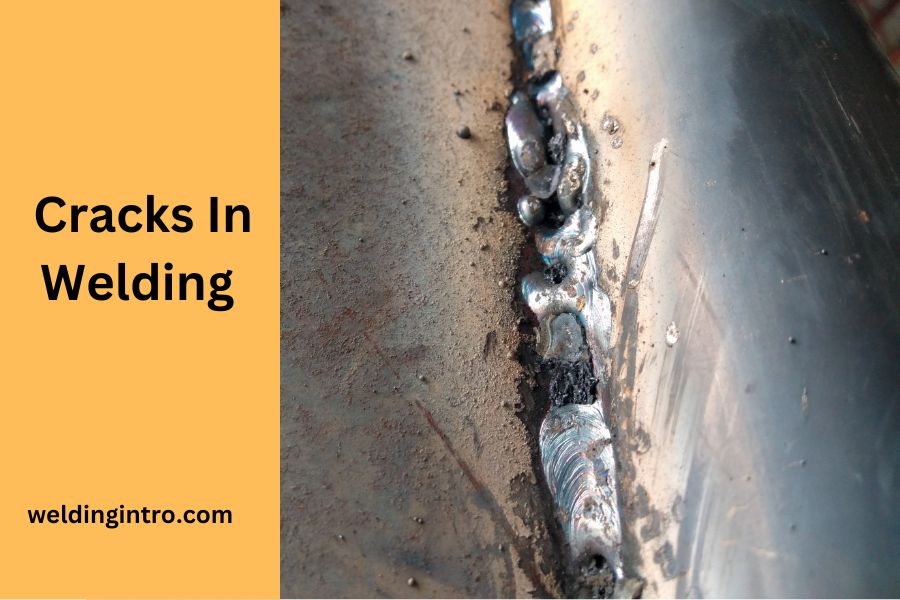Welding cracks are a common concern in the fabrication of metal structures. They can compromise the integrity and strength of a welded joint.
These imperfections arise when internal stresses—created by the welding process itself—exceed the material’s ability to withstand them.
Welding induces these stresses through the localized heating and cooling cycle, which can cause the metal to expand and contract unevenly. Understanding the different types of cracks that can occur, such as hot and cold cracks, is crucial for any welder.
Hot cracks form during the solidification process as the weld cools, whereas cold cracks can develop hours or even days after the weld has been completed.
Various factors can influence the risk of welding cracks, including your choice of welding technique, the materials welded, and the welding environment.
For example, controlling the heat input and ensuring proper cleaning of the base material are key steps in preventing such defects. It’s essential to be aware of the entire weld process, from preparation to post-weld treatment, to minimize residual stresses and avoid the onset of cracking.
Equally important is knowing how to address them if they do occur, through repair methods that might involve grinding out and rewelding, depending on the severity and location of the crack.
Key Takeaways
- Understanding and identifying welding cracks is vital to maintaining weld integrity.
- Prevention methods are as important as repair strategies to manage welding cracks effectively.
- Regular inspection and adherence to proper welding techniques minimize the risk of weld cracking.
Identifying Different Welding Cracks

Welding cracks are critical weld defects that undermine the structural integrity of welded joints. Thorough understanding of the types helps in preventing them effectively.
1. Hot Cracking and Its Causes
Hot cracks occur in the weld pool as it solidifies. This welding defect happens primarily due to the alloy’s grain structure being unable to withstand shrinkage as the high-heat input from welding cools down rapidly.
The chemical composition of the metal plays a role as certain elements can worsen the cracking.
A fine-grain structure formed during rapid cooling or high heat input enhances the susceptibility to hot cracking.
2. Cold Cracking and Causes
Cold cracking, also known as hydrogen-induced cracking, often develops hours or days after the weld has cooled.
Causes include high hydrogen content, internal stresses, and the formation of hard and brittle microstructures like martensite. To prevent cold cracks, it’s essential to control hydrogen diffusion.
It can stem from moisture or contaminants in the base material or electrodes. Preheating steel plates, post-weld heat treatment, and using low-hydrogen welding processes minimize the chances of such defects.
3. Stress-Related Weld Cracks
Stresses that exceed the metal’s strength can manifest in stress-related weld cracks such as longitudinal cracks. It runs along a weld’s axis, and lamellar tearing, which occurs beneath the weld.
These are often the result of stress concentration at weld toes or internal stresses due to the restraint of the base material.
Employing proper joint design and welding technique can reduce stress risers and residual stress, mitigating your risk of stress-related cracking.
Practical Tips for Welding Crack Prevention
To maintain the integrity of your welds and prevent cracking, specific practices must be adhered to.
This includes thorough preparation, understanding the materials, and utilizing advanced methods.
1. Proper Weld Preparation and Execution
Joint Preparations are fundamental for successful welds. Ensure the weld joint is clean and free of contaminants before starting.
This involves grinding to achieve a smooth surface, removing rust or paint, and avoiding improper welding technique.
Control your welding speeds and avoid rushing the process, as this can lead to lack of fusion and future cracks.
2. Understanding Welding Materials
When selecting your filler metals, consult with the manufacturer for recommendations suited to the specific steel type you’re working with.
Low-hydrogen electrodes are often preferred, especially when working with high-strength materials like low-alloy high-strength steel, to minimize the potential for liquefaction cracks.
Be wary of materials prone to cracking, such as certain machining steels or those with high phosphorus content.
3. Advanced Welding Techniques and Technologies
Embrace modern welding technology such as flux-cored arc welding (FCAW) or gas metal arc welding (GMAW) for improved weld fusion and overall quality.
Investigate specialty methods like beam welding for more precision and control. Stay updated with advancements and always align your practices with the prescribed welding procedure.
By adopting these sophisticated techniques, you’re more likely to achieve clean, sturdy welds.
In summary, aim for thoroughness in preparation, a deep understanding of materials, and an openness to advanced technologies. This trifecta will significantly reduce the occurrence of weld cracks and enhance the durability of your work.
Repair Methods for Weld Cracks
When you discover a crack in your weld, it’s crucial to choose the right repair method to ensure strength and durability.
The process can vary based on the material, such as stainless steel pipes or carbon steel, and the location of the crack — whether it’s in the weld bead or across the entire weld.
For Minimal Cracks:
- Weld Beads: Small cracks can often be repaired by simply re-welding over the cracked area with a compatible filler metal. Remember to match the filler metal closely with the base material to avoid any additional stress to the joint.
For Larger Cracks:
- Entire Weld Repairs: Sometimes, the entire welded section may need to be replaced if the crack is extensive. This is a common scenario when dealing with crucial structures where the integrity of the weld can’t be compromised.
Special Techniques:
- GTAW Technique: If you’re dealing with high-strength materials, such as stainless steel pipes, using Gas Tungsten Arc Welding (GTAW or TIG welding) can be effective.
- Stress Relief: Post-repair heat treatment is often necessary to relieve any stress that caused the initial crack, especially when working with stubborn materials like carbon steel.
Considerations for Concave Welds:
- Filler Metal Choice: With concave welds, choosing the right filler metal becomes even more important to ensure a proper fill and avoid undercuts which can lead to future cracks.
Remember, it’s crucial not just to fix the current crack but to take actions to prevent future weld cracks, whether through improved welding techniques or material selection.
Frequently Asked Questions
1. What causes cracks to form in welds?
Cracks in welds typically stem from stress concentrations in the material, which may be due to improper welding techniques, thermal cycles during welding, or material impurities. Learn more about factors leading to weld cracks and how to prevent them.
2. How can I prevent cracking when welding?
To prevent weld cracking, it’s important to maintain proper welding parameters. It includes preheating and cooling rates, and to ensure the base material and filler metals are devoid of contaminants.
Adequate parts fit-up and choosing the correct welding process also play key roles in preventing weld cracks.
3. Where are cracks most likely to occur in a weld?
Cracks may occur on the surface of a weld, within the weld metal, or in the heat-affected zone adjacent to the weld.
Places of high stress concentration, such as the end of a weld (known as a crater crack), are the most prone areas.
4. What are the different types of weld cracks?
Weld cracks can be classified into various types, such as longitudinal, transverse, crater, toe, and root cracks.
Each type has its own causes and characteristics, and they can be either hot or cold in nature, occurring at high temperatures or after the weld cools down respectively.
5. What remedies are available for cracks in welds?
Once a crack has been identified, it usually requires removal by grinding or gouging, followed by rewelding.
It’s essential to determine the root cause of the cracking to apply the appropriate remedy.
6. How can one identify cracks in a weld?
Cracks can be detected by visual inspection, though some may require non-destructive testing techniques such as dye penetrant, magnetic particle, ultrasonic, or radiographic testing to reveal.
It’s important to inspect both the weld and the adjacent base metal thoroughly.

